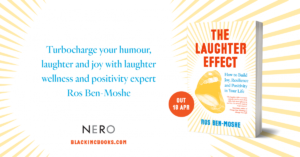Laughter, humour and joy are vital in life, and have been connecting and healing communities since Day Dot. So, let’s begin by dispelling any myths regarding humour and laughter’s therapeutic value as hippy, trippy or New Age. That is, unless you believe Adam and Eve to be so. The genesis of the Laughter Effect in Judaeo-Christian traditions is, conveniently, in the Old Testament’s Genesis.
The Bible is called the ‘Good Book’ with reason. Amid the many fire and brimstone moments in it are multiple references to happiness as the real source of wealth. The Old Testament is a veritable repository of meme-able gems hinting at laughter’s therapeutic value. ‘A merry heart doeth good like a medicine: but a broken spirit drieth the bones.’ (Proverbs 17:22) ‘Then was our mouth filled with laughter’ (Psalms 126:2), a mirthful expression of redemption and joy and gratitude to God. Such statements could easily be assumed to be attributed to meditation guru Deepak Chopra or the Dalai Lama but are as old as time itself.
Stories that reflect the application of laughter’s effect infuse the Bible, including matriarch Sarah, childless until aged ninety, who on discovering her pregnancy pronounced, ‘God has brought me laughter, and everyone who hears about this will laugh with me.’ (Genesis 21:6) The son she bears, on instruction from God, is given the name Yitzhak (Isaac), meaning ‘to laugh’ in Hebrew. Isaac’s life was far from a laugh, traversing the precipice of misfortune, although he survived adversity with unexpected joy.
Humour and laughter weren’t only crucial to Judaeo-Christian-Islamic traditions; they were also an important attribute of many ancient civilisations and indigenous cultures. So intrinsic was humour and laughter to Aboriginal and Torres Strait Islander peoples, it is embedded in their Dreaming stories of creation, dating back at least 65,000 years. The Kamilaroi people of northern New South Wales and southern Queensland say Venus occasionally twinkles when it’s low in the sky. They believe it’s an old man who told a rude joke and has been laughing ever since. Many traditional activities in Indigenous Australian encouraged laughter from swimming games to football. There was also playful communication, talking ‘gibberish’, tickling, giggling and laughing play. And on the other side of the globe, almost every Native American tribe had a personal clown or two. Working alongside a medicine man, clowns ranked third on a tribe’s totem pole.
In many classical civilisations laughter was part and parcel of the healing process, Ancient Greek physicians used to prescribe a visit to the hall of comedians. Can you imagine if GPs suggested that today? Even the royals were fond of a laugh. One particular court jester was said to have kept Queen Elizabeth I in better health than her physicians. When she was out of good humour, he would lighten her mood, curing her melancholy better than all of her physicians.
Intuitively we know laughter to have therapeutic benefits. We feel better after a hearty laugh. It therefore should come as no surprise that laughter and humour were fundamental to human evolution, as comprehensively explored by Charles Darwin. Indeed, a smile or shared laugh satiates an evolutionary survival role. This is because it’s a critical inner resource bestowed to every one of us. We witness laughter and smiling from the earliest stages of our development. We ha ha before we da da or ma ma. No matter what your background, age or where you’re situated in the world, we all smile and laugh in the same language. A visual demonstration of love, a smile optimises our chances of survival by enhancing bonding with our caregivers and increasing the chance of timely attention.
Behaviourally, first comes smiling, then comes a baby’s first laugh – a reassuring and joyful sign that bub is healthy, happy and all is well. It’s a joyful feedback loop enhancing connection and affection, a moment captured for posterity in a baby journal (or by today’s parenting generation, on Twitter, Instagram or TikTok – or all the above). However, nothing compares to the Native American Navajo’s (known as the Diné) First Laugh Ceremony, A’wee Chi’deedloh. To the Navajo, a baby’s first laugh is seen as a sign of the baby transcending their spiritual existence and indicating readiness to join their family and community in life and love. From around three months of age, caregivers and other family members compete with one another to elicit the first hallowed laugh by tickling, peek-a-booing, poking and silly faces. Whoever wins hosts a First Laugh Ceremony to celebrate the successful transition of the baby into the world. As a mark of respect to the family they’re born into and to honour the spiritual world, the baby is considered the ceremonial host, and each guest receives a plate of food, rock salt (symbolising tears shed through loss or sadness and connection to the earth) and a bag of goodies. The expressed desire is that the baby will always experience togetherness among family and friends throughout life.
No matter the culture, the more positive early smiling and laughter interactions with main caregivers are, the safer and more loved a child feels. It lays the foundation for managing emotional responses through life. The stronger this laughter/smiling ‘scaffolding’ is, the better, otherwise a few bad experiences may result in it tumbling down, like a Jenga tower. This can lead to feeling less confident to laugh freely without fear of judgement and create an unconscious suppression of laughter.
A universal language, across societies we guffaw, chuckle, chortle, howl, snigger, roar, snort, titter, hoot, whoop, snicker and cackle. Our cultural background shapes our laugh-print. Many Asian cultures have an introverted laugh-print. Social etiquette dictates, especially for women, that it’s far more polite to titter behind one’s hands, as bearing one’s teeth is ‘unlady-like’. A common practice in several Asian countries was for women to dye their teeth black (known in Japanese as ohaguro), regarded as both a status symbol and a way of preventing tooth decay. While this practice has largely gone out of vogue, perhaps in part it has served to evolutionarily decommission a toothy grin? Confucianism, which teaches that public displays of emotion should be repressed to ‘save face’, has influenced Korean etiquette. Not only do many Korean women cover their mouths whenever they laugh or smile, but to this day many turn their heads away from others.
This is in stark contrast to the Mbuti people of the Ituri Forest, located in the Democratic Republic of the Congo. Their laugh-print is physical to the extreme. British-American anthropologist and writer Colin Turnbull, the only Western writer known to have witnessed the Mbuti laughing, observed them lying down and kicking their legs in the air, panting and shaking in outbursts of hilarity. While this might seem exuberant, for these indigenous people it is their norm.
While laughter is a subconscious, innate behaviour, over time and in response to cues from our external environment regarding social mores, our conscious mind overrides the free-spirited nature of laughter – an anchor to our natural state of joy. Children laugh a lot. It’s only with conditioning and the application of adult sensibilities that the ability to laugh freely and wholly is robbed. We think laughter and don’t do laughter. We weigh up the benefit or deficit of laughing out of turn. Is it appropriate to laugh now? What will people think of me? I’m sure they’re laughing at me, not with me. I’m in a serious job now and my boss will think less of me if it seems I’m having too much fun. And so it goes until, over time, our laugh-out-loud response becomes more and more subdued and repressed. Then one day, we’re exposed to a humorous scenario, and guess what? Do we laugh? Nope. We have gone so far down the rabbit hole of seriosity that instead of an outburst of laughter, out spurts, ‘That’s funny!’ Or if something even funnier happens, this clincher, ‘That’s really funny!’
Which doesn’t mean to say we should encourage a practice of laughing all the time. As exhilarating as that may sound, not only would it be exhausting but there would also be no demarcation between life’s highs and lows. Life isn’t always a barrel of laughs. It wasn’t designed to be. In good news, it transpires you can increase your laughter quotient without needing to join the Comedy Festival circuit.
Conversations rather than comedy may be the key to how much laughter we’re getting. Specifically, the quality and quantity of our conversations. The late Robert Provine, a professor of neurobiology and psychology at the University of Maryland, found that laughter occurs thirty times more frequently in social rather than solitary situations. Contrary to our belief that laughter is by and large generated by a comedian or practical joker, Provine’s team discovered that only 10 to 20 per cent of the laughter episodes were caused by jokes. Common statements such as, ‘It was nice meeting you, too’ – hardly comedy gold – were far more likely to produce laughter. Laughter punctuating the beginning and end of sentences. Whilst the laughter might not be as uproarious as an hilarious gag, it is a great way to get your daily dose of positive wellbeing, as a range of feel-good hormones are released. Providing our DOSE – dopamine, oxytocin, serotonin and endorphins – a natural antidote to counter stress hormones.
So, let’s get back to basics and activate this fundamental human trait – laughter. An evolutionary survival, or as I’d prefer to say, “thrival” mechanism. We’ve been drawing on this innate resource for centuries. A universal language, connecting, healing and bonding people from all corners of the globe and pockets of history, helping us thrive and enabling us to be more present with one another.
——————
“The Laughter Effect – How to Build Joy, Resilience and Positivity in Your Life” out now in all good bookstores, libraries and as an e-book and audio book.



1 Comment
Pingback: The Laughter Effect – a pathway to joy and positive wellbeing — Jewish Women of Words